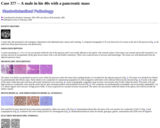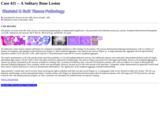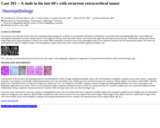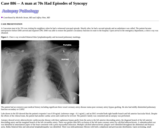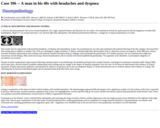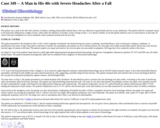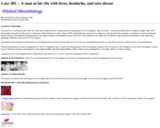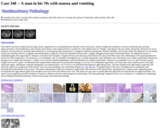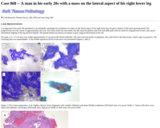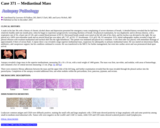
(This case study was added to OER Commons as one of a batch of over 700. It has relevant information which may include medical imagery, lab results, and history where relevant. A link to the final diagnosis can be found at the end of the case study for review. The first paragraph of the case study -- typically, but not always the clinical presentation -- is provided below.)
A male in his late 30s with a history of chronic alcohol abuse and depression presented the emergency room complaining of severe shortness of breath. A detailed history revealed that he had been relatively healthy until one month prior, when he began to experience progressively worsening shortness of breath. On physical examination, he was diaphoretic and in obvious distress, with a respiratory rate of 36, a heart rate of 120, and a seated blood pressure of 81/32. Decreased breath sounds were noted on the left side of his chest, and his trachea was deviated to the right. He was placed on a 100% non-rebreather mask and an arterial blood gas was taken: pH: 7.07, pCO2: 57, bicarbonate: 15.9, pO2: 96, O2 saturation: 91%. Initial radiographic studies revealed a large left pleural effusion with resultant mediastinal and tracheal shift into the right hemithorax. The patient was intubated and placed on a ventilator. A left chest tube was placed, with immediate drainage of approximately 4 liters of serous fluid. A repeat chest x-ray revealed a large superior mediastinal mass, suspicious for adenopathy or primary mediastinal tumor. He was started on intravenous fluids, antibiotics, and vasopressor support, but his condition continued to worsen. He was transferred to the MICU for further management, but went into cardiac arrest and was pronounced dead upon arrival.
- Subject:
- Applied Science
- Education
- Health, Medicine and Nursing
- Life Science
- Material Type:
- Case Study
- Diagram/Illustration
- Provider:
- University of Pittsburgh School of Medicine
- Provider Set:
- Department of Pathology
- Author:
- Beth Z Clark
- Larry Nichols
- Lawrence B Fialkow
- Date Added:
- 08/01/2022
